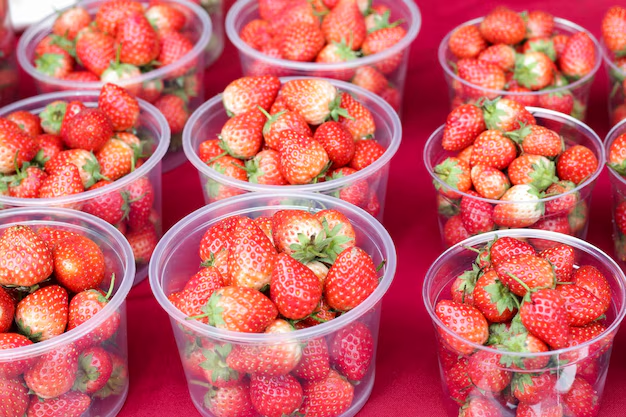Should You Refrigerate Strawberries? A Comprehensive Guide to Keeping Them Fresh 🍓
Strawberries. These vibrant red gems often evoke thoughts of summer, sweetness, and health. But when it comes to preserving their freshness, many find themselves asking: Should I put strawberries in the refrigerator? This question delves into more than just kitchen habits; it delves into the science of food preservation and the nuances of consumer preferences. Let’s explore this subject from multiple angles to help you make an informed decision.
The Strawberries' Shelf Life Dilemma
Natural Freshness vs. Extended Cooling
Strawberries are a delicate fruit, susceptible to rapid spoilage due to their high moisture content. Naturally, strawberries thrive in a cool, dry environment, which helps slow down the deterioration process. Generally, refrigeration can extend the shelf life of strawberries from just a couple of days to about a week.
Key Insight: Refrigerating strawberries can help delay spoilage, but there are nuances to consider when making this decision.
The Pros and Cons of Refrigerating Strawberries
Pros 🍓
Longevity: Cooling can significantly extend a strawberry's lifespan. By reducing the growth rate of spoilage-inducing organisms, refrigeration keeps strawberries edible for a longer period.
Preservation of Nutrients: While refrigeration doesn't necessarily increase nutrients, it does help retain the existing vitamin C and antioxidant levels over time.
Convenience: Having strawberries ready to go in your fridge can make it easier to incorporate them into your meals and snacks.
Cons ❌
Flavor and Texture Concerns: Cold temperatures can slightly alter the texture and flavor of strawberries, making them less juicy and aromatic. They may lose some of their natural sweetness when put in the fridge.
Moisture Risks: If not stored properly, strawberries can absorb excess moisture from the refrigerator, leading to sogginess and mold.
Out of Sight, Out of Mind: Sometimes, placing them in the fridge can lead to forgetting about them until they're past their prime, which defeats the purpose.
Optimal Storage Techniques for Freshness
Countertop Storage vs. Refrigeration: Which is Best?
Countertop Storage
Ideal for: Short-term storage when you plan to consume strawberries within a day or two.
Method: Keep strawberries in a cool, shaded area away from direct sunlight, and ensure they are dry and well-ventilated. This method allows the strawberries to maintain their natural texture and sweetness.
Refrigeration
Ideal for: Extending freshness when you don’t plan to eat them immediately.
Method:
- Do not wash strawberries before refrigeration, as moisture can hasten spoilage.
- Store them in a breathable container. This can be a perforated bowl or basket lined with paper towels to absorb any excess moisture.
- Place them in the crisper drawer, where humidity is naturally lower.
Freezing Strawberries for All-Year Enjoyment
When fresh strawberries are abundant, freezing is a great way to preserve their essence. To freeze:
- Wash and hull strawberries thoroughly.
- Pat them dry and spread them on a baking sheet to freeze individually.
- Once frozen, transfer them to an airtight container for up to a year.
Occasionally using frozen strawberries can make nutritious smoothies or delectable dessert toppings when fresh options aren't available.
Common Questions About Strawberries and Refrigeration
How Can I Tell If My Strawberries Are Spoiling?
Signs of spoilage include:
- Mold: The appearance of white or green fuzz indicates that they’re no longer good to eat.
- Soft Spots: Mushy areas suggest the strawberry is beginning to decompose.
- Off Smell: Strawberries past their prime can emit a sour or fermented odor.
Can Washing Strawberries Extend Their Shelf Life?
Interestingly, washing strawberries only when ready to eat helps maintain freshness. Washing before refrigerator storage introduces moisture, increasing the risk of mold and spoilage.
Practical Tips for Maintaining Strawberry Freshness
To help you maximize the shelf life of strawberries, follow these practical points:
- 🌿 Handle with Care: Avoid stacking strawberries too deeply in containers, which can bruise them.
- 🛁 Avoid Excess Moisture: Keep them dry during storage; wash them only before eating.
- 🔄 Regular Check-ins: Routinely sort through strawberries, removing any that show signs of spoilage.
- 🍃 Fresh is Best: For peak flavor and texture, consume strawberries at room temperature when possible.
Bigger Picture: Understanding Berry Storage Overall
Strawberries are just one type of berry often debated when it comes to storage. Raspberries, blueberries, and blackberries share similar storage needs, reliant on climate conditions and natural moisture levels. Here's a quick guide to storing these berries effectively:
Berry Storage Insights
- Raspberries and Blackberries: Fragile like strawberries, benefiting from a cold, dry environment.
- Blueberries: More resilient, they thrive both in the fridge and at room temperature for a few days.
Note: Always clean these berries just before use to prevent hastening decay.
Final Thoughts on Strawberry Storage
Deciding whether to refrigerate strawberries can depend on a variety of factors, such as when you plan to enjoy them and how you intend to use them. Given their wants and whims, strawberries are best when safeguarded from too much moisture and cold. By understanding these principles, you not only enjoy greater freshness but also reduce food waste and enhance your culinary experiences.
Remember, the ultimate goal is to enjoy strawberries at their peak—whether it's from the countertop or the cooling comforts of your fridge. Embrace the journey and indulge in the sweet simplicity of strawberries, knowing each choice comes with its own delights and discoveries. 🍓
